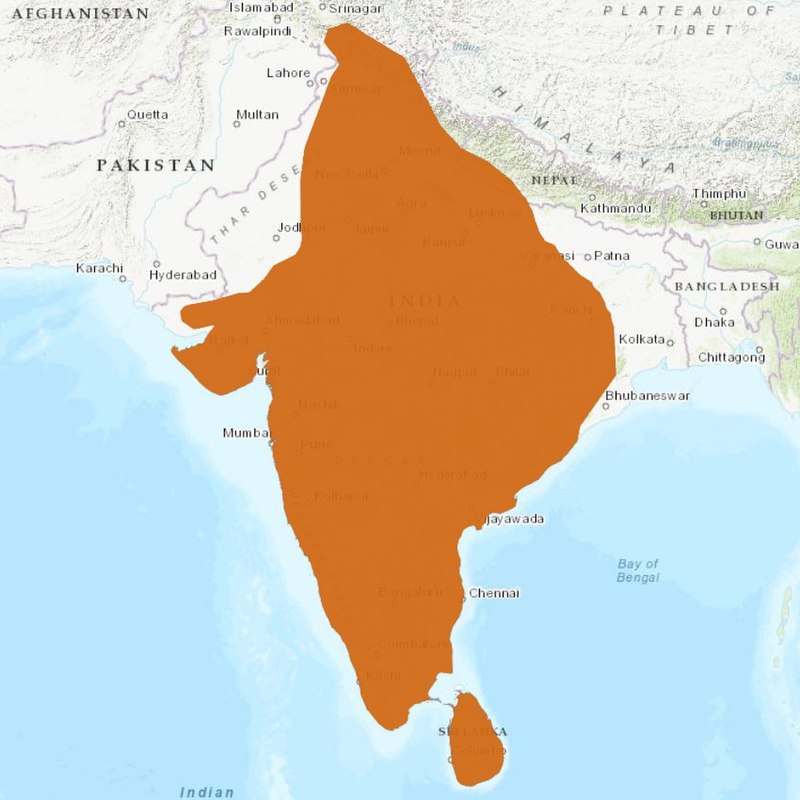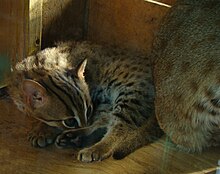Characteristics
The rusty-spotted cat is the smallest wild cat in Asia and rivals the black-footed cat as the world's smallest wild cat. It is 35 to 48 cm (14 to 19 in) in length, with a 15 to 30 cm (5.9 to 11.8 in) tail, and weighs only 0.9 to 1.6 kg (2.0 to 3.5 lb). The short fur is grey over most of the body, with rusty spots over the back and flanks, while the underbelly is white with large dark spots. The darker colored tail is thick and about half the length of the body, and the spots are less distinct. There are six dark streaks on each side of the head, extending over the cheeks and forehead.[5]
Taxonomy
Felis rubiginosa was the scientific name used by Isidore Geoffroy Saint-Hilaire in 1831 for a rusty-spotted cat specimen from Pondicherry, India.[6] Prionailurus was proposed by Nikolai Severtzov in 1858 as a generic name.[7] Prionailurus rubiginosus phillipsi was proposed by Reginald Innes Pocock in 1939 who described a specimen from Central Province, Sri Lanka and subordinated both to the genus Prionailurus.[3]Distribution and habitat
Rusty-spotted cat photographed in the Anaimalai Hills in southern India
Rusty-spotted cat in its natural habitat
In India, it was long thought to be confined to the south, but records have established that it is found over much of the country.[8] It was observed in eastern Gujarat's Gir National Park, in Maharashtra's Tadoba-Andhari Tiger Reserve and along India's Eastern Ghats.[10][11][12][13][14] Camera trapping revealed its presence in Pilibhit Tiger Reserve in the Indian Terai and in Nagzira Wildlife Sanctuary in Maharashtra.[15][16] In western Maharashtra, there is a breeding population of rusty-spotted cats in a human dominated agricultural landscape, where rodent densities are high.[17] In December 2014 and in April 2015, it was photographed by camera traps in Kalesar National Park, Haryana.[18] It was also discovered using camera traps in Mirzapur Forest Division of Uttar Pradesh in 2018.[19][20][21]
In March 2012, a rusty-spotted cat was photographed in Bardia National Park for the first time, and in March 2016 also in Shuklaphanta National Park, both in Nepal.[4][22]
In Sri Lanka, there are a few records from montane and lowland rainforest. There are two distinct populations, one in the dry zone and the other in the wet zone.[23] In 2016, it was recorded for the first time in Horton Plains National Park at elevations of 2,084–2,162 m (6,837–7,093 ft).[24]
Ecology and behaviour
Very little is known about the ecology and behaviour of rusty-spotted cats in the wild. Captive ones are mostly nocturnal but also briefly active during the day.[5] Most wild ones were also recorded after dark. At Horton Plain National Park in Sri Lanka, they were mostly recorded between sunset and sunrise, with limited daytime activity.[24] Several individuals were observed hiding in trees and in caves.[25][26][27]They feed mainly on rodents and birds, but may also hunt lizards, frogs, and insects. They hunt primarily on the ground, making rapid, darting movements to catch their prey. They apparently venture into trees to escape larger predators. Captive females and males both scent-mark their home range by spraying urine.[5]
Reproduction
A kitten of rusty-spotted cat at the Parc des Félins, France
Threats
Habitat loss and the spread of cultivation are serious problems for wildlife in both India and Sri Lanka. Although there are several records of rusty-spotted cats from cultivated and settled areas, it is not known to what degree cat populations are able to persist in such areas. There have been occasional reports of rusty-spotted cat skins in trade.[8] In some areas, they are hunted for food or as livestock pests.[5]Conservation
Rusty-spotted cat in Berlin Zoo, 2008
As of 2010, the captive population of P. r. phillipsi comprised 56 individuals in eight institutions, of which 11 individuals were kept in the Colombo Zoo in Sri Lanka and 45 individuals in seven European zoos.[28]
Local names
In Sri Lanka, the rusty-spotted cat is known as "kola diviya" or "balal diviya".[29]Prionailurus rubiginosus[1]
(Geoffroy Saint-Hilaire, 1834)

Distribution of the Rusty-spotted Cat in 2016[2]





No comments:
Post a Comment
Note: Only a member of this blog may post a comment.